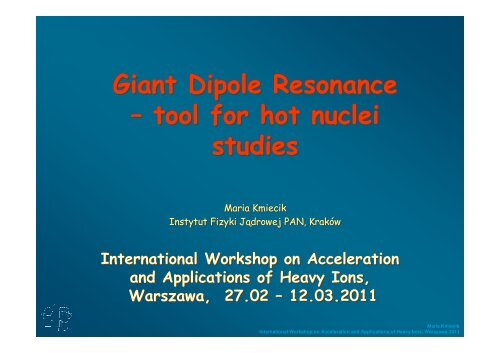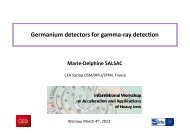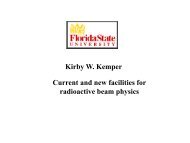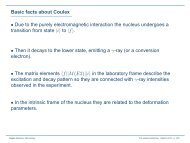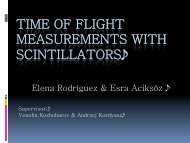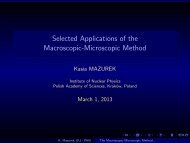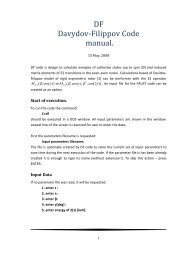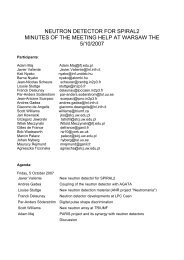Giant Dipole Resonance â tool for hot nuclei studies Giant Dipole ...
Giant Dipole Resonance â tool for hot nuclei studies Giant Dipole ...
Giant Dipole Resonance â tool for hot nuclei studies Giant Dipole ...
Create successful ePaper yourself
Turn your PDF publications into a flip-book with our unique Google optimized e-Paper software.
<strong>Giant</strong> <strong>Dipole</strong> <strong>Resonance</strong><br />
– <strong>tool</strong> <strong>for</strong> <strong>hot</strong> <strong>nuclei</strong><br />
<strong>studies</strong><br />
Maria Kmiecik<br />
Instytut Fizyki Jądrowej PAN, Kraków<br />
International Workshop on Acceleration<br />
and Applications of Heavy Ions,<br />
Warszawa, 27.02 – 12.03.2011<br />
Maria Kmiecik<br />
International Workshop on Acceleration and Applications of Heavy Ions, Warszawa 2011
The properties of <strong>Giant</strong> <strong>Dipole</strong> <strong>Resonance</strong>s<br />
GDR as a <strong>tool</strong> <strong>for</strong> excited <strong>nuclei</strong> <strong>studies</strong><br />
The results of the measurements:<br />
<br />
<br />
<br />
GDR width as a function of spin and temperature<br />
of nucleus<br />
The exotic shapes investigation<br />
Isospin mixing<br />
Perspectives<br />
Maria Kmiecik<br />
International Workshop on Acceleration and Applications of Heavy Ions, Warszawa 2011
<strong>Giant</strong> Nuclear <strong>Resonance</strong>s<br />
Collective excitations of atomic <strong>nuclei</strong><br />
consisting in oscillations of nucleons.<br />
Called giant resonances (giant vibrations) because<br />
of large cross sections, close to maximum allowed<br />
<strong>for</strong> all nucleons participating in excitation<br />
At the microscopic level giant resonances can<br />
be described in terms of correlated particle-hole<br />
excitations<br />
Maria Kmiecik<br />
International Workshop on Acceleration and Applications of Heavy Ions, Warszawa 2011
<strong>Giant</strong> Nuclear <strong>Resonance</strong>s<br />
Usually classified in terms of three characteristic quantum numbers:<br />
L, S, and T, where L - the orbital angular momentum,<br />
S - the (intrinsic) spin,<br />
T - the isospin carried by the resonance oscillation.<br />
∆L=0<br />
∆L=1<br />
∆L=2<br />
Maria Kmiecik<br />
International Workshop on Acceleration and Applications of Heavy Ions, Warszawa 2011
Electric <strong>Giant</strong> <strong>Resonance</strong>s<br />
Isoscalar<br />
Isovector<br />
Monopole<br />
1977<br />
1983<br />
<strong>Dipole</strong><br />
1996<br />
1948<br />
Quadrupole<br />
1971<br />
1980<br />
Maria Kmiecik<br />
International Workshop on Acceleration and Applications of Heavy Ions, Warszawa 2011
<strong>Giant</strong> <strong>Dipole</strong> <strong>Resonance</strong><br />
The giant electric dipole isovector resonance –<br />
giant dipole resonance (GDR) is the oldest and best<br />
known of the nuclear giant resonances.<br />
Observed <strong>for</strong> the first time in 1947 and 1948<br />
by Baldwin and Klaiber in (γ,fission) and (γ,n)<br />
reactions<br />
Measured using p<strong>hot</strong>oabsorbtion<br />
reactions <strong>for</strong> different <strong>nuclei</strong><br />
from 3 He to 238 U<br />
(Berman and Fultz 1975)<br />
Maria Kmiecik<br />
International Workshop on Acceleration and Applications of Heavy Ions, Warszawa 2011
Ground state GDR<br />
σ(E γ )<br />
P<strong>hot</strong>oabsorbtion cross section –<br />
GDR strength<br />
function:<br />
Γ<br />
A<br />
E GDR<br />
Strength σ 0 =1 (S GDR )<br />
(maximum corresponding to 100% of nucleons<br />
participating in oscillations<br />
calculated from Energy Weighted Sum Rule –<br />
giant vibration, large collectivity)<br />
A<br />
Energy – centroid (E GDR ):<br />
energy of oscillations ~ 1/R<br />
Width (Γ GDR )<br />
Γ ~ -1/t<br />
Maria Kmiecik<br />
International Workshop on Acceleration and Applications of Heavy Ions, Warszawa 2011
GDR lineshape – de<strong>for</strong>med nucleus<br />
superposition<br />
of two Lorentzian function<br />
σ ( E<br />
γ<br />
σ ( E<br />
k<br />
) = σ ( E<br />
γ<br />
) =<br />
1<br />
( E<br />
2<br />
γ<br />
γ<br />
) + σ ( E<br />
σ Γ<br />
− E<br />
2<br />
2<br />
0 k<br />
2 2<br />
k<br />
)<br />
E<br />
2<br />
γ<br />
γ<br />
+ Γ<br />
Hill-Wheeler parameterization<br />
E<br />
E<br />
k<br />
= E<br />
GDR<br />
GDR<br />
R<br />
R<br />
≈ 79A<br />
k<br />
1<br />
−<br />
3<br />
= E<br />
GDR<br />
),<br />
2<br />
k<br />
E<br />
⎡<br />
exp⎢−<br />
⎣<br />
2<br />
γ<br />
5 2πk<br />
⎤<br />
β cos( γ + ) ⎥,<br />
4π<br />
3 ⎦<br />
quadrupole de<strong>for</strong>mation parameter β<br />
β =<br />
E<br />
4π<br />
E<br />
5 E<br />
0.5<br />
E<br />
2<br />
1<br />
2<br />
1<br />
−1<br />
+ 0.87<br />
Maria Kmiecik<br />
International Workshop on Acceleration and Applications of Heavy Ions, Warszawa 2011
GDR in excited <strong>nuclei</strong><br />
GDR can be built on excited state of nucleus - Brink hypothesis, , 1955<br />
Maria Kmiecik<br />
International Workshop on Acceleration and Applications of Heavy Ions, Warszawa 2011
Fusion – evaporation reaction.<br />
Excerpt from the © Jerzy Grebosz movie „Mysterious World of Atomic Nuclei”<br />
Maria Kmiecik<br />
International Workshop on Acceleration and Applications of Heavy Ions, Warszawa 2011
Decay of compound nucleus<br />
E * [MeV]<br />
p<br />
p<br />
90<br />
t<br />
t<br />
jądro złożone<br />
80<br />
σ(L)<br />
70<br />
n<br />
60<br />
GDR γ<br />
Statistical decay<br />
50<br />
n<br />
α<br />
T ∝ E<br />
* − E yrast<br />
40<br />
n GDR γ<br />
n<br />
30<br />
n<br />
20<br />
E yrast<br />
10<br />
E yrast<br />
+ B n<br />
0<br />
0 10 20 30 40 50 60 70<br />
n<br />
L [h]<br />
p<br />
GDR γ<br />
Maria Kmiecik<br />
International Workshop on Acceleration and Applications of Heavy Ions, Warszawa 2011
Energy spectrum of emitted γ rays<br />
37<br />
Ar<br />
1<br />
2<br />
3<br />
4<br />
Continous spectrum<br />
Maria Kmiecik<br />
International Workshop on Acceleration and Applications of Heavy Ions, Warszawa 2011
Extraction of GDR parameters<br />
10 2<br />
σ<br />
( E )<br />
γ<br />
=<br />
2 2<br />
2 2<br />
( E − E ) + Γ E<br />
γ<br />
SΓE<br />
GDR<br />
γ<br />
2<br />
γ<br />
0.10<br />
Zliczenia [a. u.]<br />
Y γ<br />
10 1<br />
10 0<br />
10 -1<br />
10 -2<br />
10 -3<br />
CASCADE<br />
detector’s response<br />
function<br />
0.06<br />
0.02<br />
Γ<br />
6 10 14 18 22<br />
E [MeV]<br />
γ<br />
10 -4<br />
χ 2 - minimization<br />
10 -5<br />
5 10 15 20 25<br />
E γ [MeV]<br />
0.10<br />
σ<br />
( E )<br />
de<strong>for</strong>mation parameter<br />
of nucleus<br />
γ<br />
=<br />
1<br />
1<br />
2 2<br />
2 2 2 2<br />
2 2<br />
( E − E ) + Γ E ( E − E ) + Γ E<br />
γ<br />
S Γ E<br />
GDR 1<br />
2<br />
γ<br />
1<br />
γ<br />
+<br />
γ<br />
S<br />
2<br />
Γ<br />
2<br />
GDR 2<br />
E<br />
2<br />
γ<br />
2<br />
γ<br />
0.06<br />
0.02<br />
E − E<br />
β ≈ 106 .<br />
2 1<br />
6 10 14 18 22<br />
E GDR E [MeV] γ<br />
Maria Kmiecik<br />
International Workshop on Acceleration and Applications of Heavy Ions, Warszawa 2011
Thermal shape fluctuations<br />
probability of existing a nucleus<br />
at given shape (described by β and γ)<br />
⎡<br />
P ( T , ϖ ; β , γ ) ∝ exp −<br />
⎣⎢<br />
F ( T , ϖ ; β , γ ) ⎤<br />
T ⎦⎥<br />
Shapes ensemble<br />
Maria Kmiecik<br />
International Workshop on Acceleration and Applications of Heavy Ions, Warszawa 2011
Thermal shape fluctuations<br />
P( β , γ )<br />
∝<br />
e<br />
− F ( β , γ )<br />
T<br />
β eq<br />
0.4<br />
0.3<br />
106-110 Sn T~1.8 MeV<br />
β eq<br />
∆β<br />
0.2<br />
0.1<br />
∆β<br />
0.0<br />
0 10 20 30 40 50 60<br />
I [h]<br />
β eq<br />
eq<br />
~ I<br />
∆β ~ T<br />
β equilibrium<br />
(the<br />
most probable)<br />
f<br />
GDR strength function (average – measured):<br />
av<br />
GDR<br />
∫∫<br />
−F<br />
( T , I ; β , γ )/ T ( I ; β , γ ) 4<br />
( T,<br />
I ) = f ( β,<br />
γ , ω)<br />
e<br />
β sin(3γ<br />
) dβdγ<br />
GDR<br />
Maria Kmiecik<br />
International Workshop on Acceleration and Applications of Heavy Ions, Warszawa 2011
HECTOR (High Energy gamma-ray deteCTOR) array:<br />
(Copenhagen)-Milano-Kraków collaboration since 1989<br />
HECTOR - 8 large BaF 2 detectors<br />
high energy<br />
γ-ray spectra<br />
10 2<br />
10 1<br />
10 0<br />
Zliczenia<br />
10 -1<br />
10 -2<br />
10 -3<br />
10 -4<br />
10 -5<br />
5 10 15 20 25<br />
E γ [MeV]<br />
neutron discrimination using time of flight<br />
time<br />
time<br />
HELENA multiplicity filter (38 small BaF 2 )<br />
counts<br />
sum energy<br />
fold (measured<br />
multiplicity)<br />
σ [mb]<br />
22<br />
18<br />
14<br />
10<br />
E lab<br />
= 170 MeV<br />
E lab<br />
= 165 MeV<br />
E lab<br />
= 160 MeV<br />
fold 5-30<br />
fold 8-30<br />
channel<br />
spin distributions<br />
6<br />
2<br />
fold 5-7<br />
0 10 20 30 40 50 60<br />
l [h]<br />
Maria Kmiecik<br />
International Workshop on Acceleration and Applications of Heavy Ions, Warszawa 2011
Measurements<br />
EB IV + HECTOR + EUCLIDES exp.<br />
HECTOR + NORDBALL<br />
<br />
<br />
<br />
<br />
HECTOR – GDR<br />
EUROBALL,<br />
NORDBALL, PEX –<br />
discrete transitions<br />
multiplicity filter<br />
(spin) HELENA<br />
light charged<br />
particles<br />
(EUCLIDES,<br />
GARFIELD)<br />
HECTOR + PEX<br />
GARFIELD<br />
HECTOR<br />
Maria Kmiecik<br />
International Workshop on Acceleration and Applications of Heavy Ions, Warszawa 2011
The dependence<br />
of the GDR width<br />
on angular momentum<br />
Maria Kmiecik<br />
International Workshop on Acceleration and Applications of Heavy Ions, Warszawa 2011
GDR width Γ and de<strong>for</strong>mation parameter β<br />
<strong>for</strong> 147 Eu<br />
M. Kmiecik et al. Nucl. Phys. A674 (2000) 29<br />
Γ [MeV]<br />
10.5<br />
10.0<br />
9.5<br />
9.0<br />
8.5<br />
8.0<br />
7.5<br />
0.4<br />
0.3<br />
170 MeV, 165 MeV, 160 MeV<br />
Γ (T=1.2)<br />
Γ (T=1.4)<br />
Γ global (T=1.3)<br />
β av (T=1.2)<br />
β av (T=1.4)<br />
β<br />
av<br />
∆β<br />
=<br />
F<br />
D α −<br />
−1<br />
[ ] β<br />
T<br />
= Z ∫ 3<br />
e , Z =<br />
2<br />
I<br />
β<br />
2<br />
<strong>for</strong> ∆β<br />
> β<br />
<strong>for</strong> β<br />
eq<br />
eq<br />
> ∆β<br />
− β<br />
β<br />
β<br />
2<br />
av<br />
av<br />
av<br />
∫<br />
slightly ↑<br />
D[ α]<br />
3<br />
e<br />
2<br />
I<br />
<strong>for</strong><br />
I<br />
↑ strongly with<br />
↑<br />
I<br />
F<br />
−<br />
T<br />
↑<br />
β<br />
0.2<br />
0.1<br />
β eq (T=1.2)<br />
β eq (T=1.4)<br />
0.0<br />
0 10 20 30 40 50 60<br />
< I > [h]<br />
The GDR width increases<br />
due to de<strong>for</strong>mation increase<br />
and thermal shape fluctuations<br />
Maria Kmiecik<br />
International Workshop on Acceleration and Applications of Heavy Ions, Warszawa 2011
Isomer gated GDR 96 MeV 18 O + 198 Pt → 216 Rn *<br />
M. Kmiecik et al. PR C70, 064317 (2005)<br />
E * =56MeV, L max =39h<br />
Γ [MeV]<br />
β<br />
9<br />
8<br />
7<br />
6<br />
0.5<br />
0.4<br />
0.3<br />
0.2<br />
0.1<br />
0.0<br />
exp. fold gated<br />
exp. isomer gated<br />
calc. Kusn.<br />
calc. LSD<br />
β eq<br />
<br />
<br />
0 10 20 30 40 50<br />
I [h]<br />
fission<br />
no significant increase<br />
of GDR width observed<br />
small de<strong>for</strong>mation<br />
up to the fission limit<br />
gating on isomers –<br />
choosing <strong>nuclei</strong><br />
at highest spins<br />
surviving fission<br />
0.0<br />
0.0<br />
0.5<br />
0.5<br />
1.0<br />
1.0<br />
β 2<br />
cos(γ+30 o )<br />
1.5 -0.5 0.0 0.5 0.0 0.5<br />
1.5 -0.5 0.0 0.5 0.0 0.5<br />
1.0<br />
1.0<br />
1062<br />
63/2 - 201 ns<br />
687<br />
769<br />
1299<br />
43/2 - 854<br />
14 ns<br />
211 Rn<br />
1.5 -0.5 0.0 0.5 0.0 0.5<br />
1.5 -0.5 0.0 0.5 0.0 0.5<br />
30 +<br />
I = 10 I = 16 I = 22<br />
β eq<br />
I = 28 I = 34<br />
<br />
22 + 212 Rn<br />
924<br />
1117<br />
701<br />
736<br />
154 ns<br />
968<br />
109 ns<br />
Maria Kmiecik<br />
International Workshop on Acceleration and Applications of Heavy Ions, Warszawa 2011<br />
1.0<br />
1.0<br />
1.5 -0.5 0.0 0.5<br />
I = 40<br />
1.5 -0.5 0.0 0.5<br />
β 2<br />
sin(γ+30 o )
The GDR width at finite temperature<br />
Γ [MeV]<br />
14<br />
13<br />
12<br />
11<br />
10<br />
9<br />
8<br />
7<br />
6<br />
5<br />
147 Eu T=1.3<br />
106<br />
Sn T=1.8<br />
176<br />
W T=1.5<br />
194<br />
Hg T=1.3<br />
216<br />
Rn T=0.75<br />
0 10 20 30 40 50 60<br />
< I > [h]<br />
Ι = I⋅ϖ<br />
I ∝<br />
A 5/<br />
3<br />
larger de<strong>for</strong>mation increase<br />
(at the same spin)<br />
<strong>for</strong> <strong>nuclei</strong> of smaller mass<br />
effect of rotational frequency<br />
M.Mattiuzzi et al. Nucl. Phys. A612 (1997) 262<br />
M. Kmiecik et al. Nucl. Phys. A674 (2000) 29<br />
M. Kmiecik et al., Phys. Rev. C70, 064317 (2005)<br />
F. Camera et al. Phys. Rev. C60 (1999) 014306<br />
Maria Kmiecik<br />
International Workshop on Acceleration and Applications of Heavy Ions, Warszawa 2011
The GDR width Γ behaviour<br />
as a function of <strong>nuclei</strong><br />
temperature<br />
Maria Kmiecik<br />
International Workshop on Acceleration and Applications of Heavy Ions, Warszawa 2011
The temperature evolution of GDR width<br />
Γ GDR saturation?<br />
G. Enders et al., PRL 69 (1992) 249<br />
A. Bracco et al., PRL 62 (1989) 2080<br />
T=2.5<br />
T=3.5<br />
Possible explanations:<br />
- saturation of the transferred<br />
angular momentum<br />
- preequilibrium emission<br />
P.M.Kelly et al. PRL82 (1999) 3404<br />
Maria Kmiecik<br />
International Workshop on Acceleration and Applications of Heavy Ions, Warszawa 2011
The temperature evolution of GDR width<br />
Calculations <strong>for</strong> 132 Ce<br />
Shape probability<br />
distribution<br />
Effective GDR width<br />
increases with T<br />
Maria Kmiecik<br />
International Workshop on Acceleration and Applications of Heavy Ions, Warszawa 2011
The GARFIELD+HECTOR experiment<br />
(γ rays and charged particles measured)<br />
132<br />
Ce<br />
O. Wieland et al., Phys. Rev. Lett. 97, 012501 (2006)<br />
The GDR width increases with temperature (up to 4 MeV).<br />
The results are in agreement with calculations based on thermal<br />
shape fluctuation model including compound nucleus life time.<br />
Maria Kmiecik<br />
International Workshop on Acceleration and Applications of Heavy Ions, Warszawa 2011
Jacobi shape transition<br />
Maria Kmiecik<br />
International Workshop on Acceleration and Applications of Heavy Ions, Warszawa 2011
Theoretical shapes of rotating gravitating body<br />
Colin MacLaurin (1742) showed that, as the angular momentum increases, the spherical body (Earth)<br />
will become more flat (oblate). It changes it’s s shape to an ellipsoid with two equal long axes,<br />
rotating around the short axis.<br />
McLaurin McLaurin shapes: spherical → oblate → more flat oblate<br />
24h 2,3h<br />
Jacobi shapes:<br />
Carl Gustav Jacob Jacobi in 1834<br />
calculated that at certain angular<br />
velocity the rotating body<br />
(gravitating mass rotating<br />
synchronously) may change abruptly<br />
the shape from MacLaurins oblate<br />
shape to triaxial and then more<br />
elongated. (Jacobi(<br />
bifurcation).<br />
Jacobi shapes<br />
2.4h<br />
oblate → triaxial → prolate<br />
Poincare shapes:<br />
2,4h 3,8h<br />
Poincare shapes<br />
2.5h<br />
Henri Poincare (1885) described new shapes that<br />
could be obtained by rotating mass at the Jacobi<br />
path at given angular velocity. The body having<br />
Jacobi elongated triaxial shape can change it at<br />
multiple bifurcation point a pear shape<br />
triaxial →<br />
pear shape<br />
Maria Kmiecik<br />
International Workshop on Acceleration and Applications of Heavy Ions, Warszawa 2011
Evolution of the shape of <strong>hot</strong> nucleus<br />
as a function of spin<br />
R L<br />
/R S<br />
2.0<br />
1.5<br />
1.0<br />
β<br />
168<br />
Hf<br />
2<br />
126 Ba Ba<br />
168 Hf<br />
0 10 20 30 40 50 60 70 80<br />
spherical<br />
oblate<br />
fission<br />
0.2<br />
0.1<br />
0.0<br />
R L<br />
/R S<br />
2.0<br />
1.5<br />
1.0<br />
spherical<br />
oblate<br />
triaxial<br />
prolate<br />
fission<br />
β 2<br />
0.3<br />
0.2<br />
0.1<br />
0.0<br />
0 10 20 30 40 50 60 70 80<br />
0.2<br />
I [h]<br />
”Oblate”→fission<br />
I [h] „Jacobi shapes”<br />
„Oblate” →3-axial→<br />
→”prolate”→fission<br />
0.2<br />
0.16<br />
0.16<br />
σ<br />
0.12<br />
0.08<br />
σ<br />
0.12<br />
0.08<br />
0.04<br />
0.04<br />
0<br />
5 10 15 20 25 25<br />
30 30 35<br />
30 35<br />
35<br />
E γ [MeV]<br />
0<br />
5 10 15 20<br />
20 25 25<br />
30 30<br />
35<br />
35<br />
35<br />
E γ [MeV]<br />
Maria Kmiecik<br />
International Workshop on Acceleration and Applications of Heavy Ions, Warszawa 2011
Jacobi shape transition - theoretical predictions<br />
potential energy calculated<br />
with LSD (Lublin-Strasbourg Drop) model:<br />
Dudek & Pomorski Phys. Rev. C67 (2003) 044316<br />
equilibrium shape evolution<br />
60<br />
50<br />
46 Ti<br />
40<br />
30<br />
γ<br />
20<br />
Jacobi shape transition<br />
28 29<br />
1826<br />
30<br />
10<br />
0<br />
32 34 36<br />
0<br />
0.0 0.5 1.0 1.5<br />
average shape<br />
Maria Kmiecik<br />
International Workshop on Acceleration and Applications of Heavy Ions, Warszawa 2011<br />
β<br />
10
Jacobi shape transition – GDR strength function<br />
0.28<br />
0.24<br />
0.20<br />
0.16<br />
0.12<br />
0.08<br />
0.04<br />
0.00<br />
triaxial<br />
I=27 h<br />
0 5 10 15 20 25 30 35<br />
E [MeV]<br />
0.28<br />
0.24<br />
0.20<br />
0.16<br />
0.12<br />
0.08<br />
0.04<br />
0.00<br />
prolate<br />
I=34 h<br />
0 5 10 15 20 25 30 35<br />
E [MeV]<br />
0.28<br />
0.24<br />
0.20<br />
oblate<br />
I=25 h<br />
60<br />
0.16<br />
0.12<br />
50<br />
0.08<br />
0.04<br />
0.00<br />
0 5 10 15 20 25 30 35<br />
E [MeV]<br />
46 Ti<br />
40<br />
30<br />
γ<br />
0.28<br />
0.24<br />
0.20<br />
0.16<br />
0.12<br />
0.08<br />
0.04<br />
0.00<br />
spherical<br />
I=0 h<br />
0 5 10 15 20 25 30 35<br />
E [MeV]<br />
28 29<br />
1826<br />
30<br />
10<br />
0<br />
32 34 36<br />
20<br />
10<br />
0<br />
0.0 0.5 1.0 1.5<br />
β<br />
Maria Kmiecik<br />
International Workshop on Acceleration and Applications of Heavy Ions, Warszawa 2011
First signatures<br />
of Jacobi shape<br />
transition<br />
predictions<br />
<br />
M. Kicińska<br />
ska-Habior et al.,<br />
Phys. Lett. B308 (1993) 225:<br />
Seattle exp. - Possible<br />
signature of the Jacobi shape<br />
transition <strong>for</strong> 45 Sc in the<br />
inclusive GDR spectrum<br />
0.28<br />
0.24<br />
0.20<br />
0.16<br />
0.12<br />
0.08<br />
0.04<br />
triaxial<br />
I=27 h<br />
0.00<br />
0 5 10 15 20 25 30 35<br />
E γ [MeV]<br />
E [MeV]<br />
β = 0.4, γ = -30 o<br />
5 10 15 20 25<br />
0.08<br />
0.06<br />
0.04<br />
0.02<br />
0.4<br />
0.2<br />
<br />
A. Maj et al,<br />
Nucl. Phys. A687 (2001) 192:<br />
NBI exp. – Possible signatures<br />
of the Jacobi shape transition<br />
<strong>for</strong> 46 Ti in the multiplicity<br />
gated GDR spectra and angular<br />
distributions<br />
0.0<br />
-0.2<br />
-0.4<br />
5 10 15 20 25 30<br />
E γ [MeV]<br />
Maria Kmiecik<br />
International Workshop on Acceleration and Applications of Heavy Ions, Warszawa 2011
HECTOR+EUROBALL experiment<br />
105 MeV 18 O + 28 Si ⇒ 46 Ti*<br />
L max ≈ 35 h<br />
E* = 85 MeV<br />
0.12<br />
A. Maj et al., Nucl. Phys. A731 (2004) 319c.<br />
0.12<br />
fold 2<br />
fold 6<br />
folds 11-20<br />
multiplicity<br />
gated<br />
0.08<br />
high spin<br />
folds 11-20<br />
0.08<br />
low spin<br />
fold 2<br />
[arb. units]<br />
10 4<br />
10 3<br />
[arb. units]<br />
Y γ<br />
0.04<br />
[arb. units]<br />
Y γ<br />
0.04<br />
Y γ<br />
10 5 E γ [MeV]<br />
10 2<br />
0.00<br />
4 8 12 16 20 24 28<br />
0.00<br />
4 8 12 16 20 24 28<br />
10 1<br />
E γ [MeV]<br />
E γ [MeV]<br />
4 8 12 16 20 24<br />
low energy component increasing with spin<br />
gated with<br />
γ transitions<br />
in 42 Ca residuum<br />
Maria Kmiecik<br />
International Workshop on Acceleration and Applications of Heavy Ions, Warszawa 2011
Coriolis splitting of the GDR components<br />
0.08<br />
0.06<br />
0.04<br />
0.02<br />
I=0<br />
low E<br />
high E<br />
prolate<br />
β=0.5<br />
ω=0<br />
K. Neergård, Phys. Lett. 110B (1982) 7<br />
Ω<br />
2<br />
2,3<br />
∆ =<br />
2<br />
ω<br />
2<br />
=<br />
1<br />
4<br />
2<br />
+ ω<br />
3<br />
2<br />
2<br />
+ ω ±<br />
2 2 2 2 2 2<br />
( ω − ω ) + ω ( ω + ω )<br />
2 3<br />
2<br />
J.J. Gaardhøje, A. Maj et al.,<br />
Acta. Phys. Pol. B24 (1993) 139;<br />
T. Døssing, private communication<br />
∆<br />
2<br />
3<br />
0<br />
5 10 15 20 25 30<br />
E [MeV]<br />
ω<br />
Frequency<br />
= 0 ω<br />
><br />
0<br />
0.08<br />
0.06<br />
0.04<br />
0.02<br />
0<br />
I=30<br />
5 10 15 20 25 30<br />
E [MeV]<br />
ω=2.8<br />
(I=30 <strong>for</strong> A=46)<br />
ω 1<br />
ω 2<br />
ω 3<br />
ω<br />
1<br />
Ω 2<br />
Ω 2<br />
Ω 3<br />
Ω 3<br />
+ ω<br />
− ω<br />
+ ω<br />
− ω<br />
Maria Kmiecik<br />
International Workshop on Acceleration and Applications of Heavy Ions, Warszawa 2011
LSD calculations<br />
thermal shape<br />
fluctuations +<br />
Coriolis splitting<br />
P(β,γ) ∝ exp(-F(b,g)/T)<br />
46<br />
Ti<br />
β 2<br />
sin(γ+30 o )<br />
γ = 60 o<br />
0.75<br />
0.50<br />
0.25<br />
0.00<br />
0.0<br />
0.5<br />
γ = 0 o<br />
I = 24<br />
1.0<br />
β 2<br />
cos(γ+30 o )<br />
γ = 60 o<br />
0.75<br />
0.50<br />
0.25<br />
1.5<br />
0.00<br />
0.0<br />
γ = 0 o<br />
I = 28 - 34<br />
1.0<br />
0.5<br />
β 2<br />
cos(γ+30 o )<br />
1.5<br />
f<br />
av<br />
GDR<br />
∫∫<br />
−F(<br />
T,<br />
I;<br />
γ γ<br />
T I f β γ ω e<br />
β , )/ T ( I;<br />
= β , ) 4<br />
( , ) ( , , )<br />
β sin(3 γ)<br />
dβdγ<br />
GDR<br />
Jacobi shape transition and<br />
indicated <strong>for</strong> the first time<br />
Coriolis effect<br />
[a. u.]<br />
Y γ<br />
Exp. LSD (I = 28-34) LSD (I = 24)<br />
with Coriolis<br />
A. Maj et al., Nucl. Phys. A731, 319c (2004)<br />
0 5 10 15 20 25 30 35<br />
E [MeV] γ<br />
Maria Kmiecik<br />
International Workshop on Acceleration and Applications of Heavy Ions, Warszawa 2011
GDR built on superde<strong>for</strong>med<br />
nucleus<br />
Maria Kmiecik<br />
International Workshop on Acceleration and Applications of Heavy Ions, Warszawa 2011
GDR built on superde<strong>for</strong>med nucleus - predictions<br />
60<br />
yrast ND<br />
β≈0.2<br />
50<br />
yrast SD<br />
β≈0.6<br />
E [MeV]<br />
40<br />
30<br />
20<br />
10<br />
F<br />
GDR<br />
ND<br />
5 10 15 20 25 30<br />
F<br />
GDR<br />
SD<br />
5 10 15 20 25 30<br />
B n<br />
B n<br />
0<br />
0 10 20 30 40 50 60<br />
l [h]<br />
Maria Kmiecik<br />
International Workshop on Acceleration and Applications of Heavy Ions, Warszawa 2011
GDR built on superde<strong>for</strong>med nucleus - indications<br />
37<br />
Cl(165 MeV) on 110 Pd ⇒ 147 Eu*<br />
1000<br />
100<br />
SD Gated<br />
TD gated<br />
143<br />
Eu<br />
F. Camera et al., Acta Phys. Pol. B32 (2001) 807<br />
a.u.<br />
gated on SD band<br />
10<br />
110 Pd( 37 Cl,4n) 143 Eu<br />
SD / TD<br />
1<br />
6 8 10 12<br />
Energy [MeV]<br />
Maria Kmiecik<br />
International Workshop on Acceleration and Applications of Heavy Ions, Warszawa 2011
Feeding of highly de<strong>for</strong>med states by GDR -<br />
42 Ca case<br />
2.5<br />
2.0<br />
sd sd / sfer / spher<br />
nd nd / sfer / spher<br />
sd / ndsd / nd<br />
feeding of the highly de<strong>for</strong>med states<br />
by the low energy GDR component<br />
Ratio<br />
1.5<br />
1.0<br />
0.5<br />
0.0<br />
2 4 6 8 10 12<br />
E γ [MeV]<br />
nd<br />
sd<br />
Exp. LSD (I = 28-34) LSD (I = 24)<br />
with Coriolis<br />
spher<br />
[a. u.]<br />
Y γ<br />
M. Kmiecik et al., Acta Phys. Pol. B36 (2005) 1169<br />
0 5 10 15 20 25 30 35<br />
E [MeV] γ<br />
Maria Kmiecik<br />
International Workshop on Acceleration and Applications of Heavy Ions, Warszawa 2011
Search <strong>for</strong> highly de<strong>for</strong>med states in 42 Ca using Coulomb<br />
excitation – AGATA Demonstrator experiment<br />
Experiment proposed by Adam Maj (IFJ PAN Krakow),<br />
Paweł Napiorkowski (HIL Wrasaw)<br />
and Faical Azaiez (IPNO Orsay)<br />
goal:<br />
investigate the de<strong>for</strong>mation of nucleus<br />
at states from the highly de<strong>for</strong>med band<br />
reaction:<br />
Coulomb excitation 42 Ca on 208 Pb target<br />
measured:<br />
•γ rays<br />
•back-scatered<br />
projectiles<br />
Maria Kmiecik<br />
International Workshop on Acceleration and Applications of Heavy Ions, Warszawa 2011
Isospin mixing <strong>studies</strong><br />
in Heavy Ion Laboratory<br />
in Warsaw<br />
Maria Kmiecik<br />
International Workshop on Acceleration and Applications of Heavy Ions, Warszawa 2011
GDR <strong>studies</strong> in Warszawa<br />
<br />
JANOSIK set-up<br />
<br />
<br />
25 cm x 29 cm NaI(Tl)<br />
detector <strong>for</strong> high-energy<br />
γ-ray measurement<br />
with shield (plastic + 6 LiH<br />
+ lead) to reduce cosmic<br />
background<br />
Si-Ball – p and α detection<br />
M. Kicińska-Habior et al., Acta Phys. Pol. B27 (1996)547,<br />
Acta Phys. Pol. B28 (1997)219<br />
<br />
Isospin mixing investigations<br />
GDR measured <strong>for</strong> two neighbouring<br />
N=Z and N≠Z <strong>nuclei</strong> at similar excitation energies<br />
N≠Z – GDR parameters extracted<br />
– statistical model Cascade<br />
N=Z – α 2 (isospin mixing probabilty) obtained<br />
M. Kicińska-Habior et al., Acta Phys. Pol. B36 (2005) 1133<br />
Maria Kmiecik<br />
International Workshop on Acceleration and Applications of Heavy Ions, Warszawa 2011
Isospin mixing<br />
M. Kicińska-Habior et al., Nucl. Phys. A731c (2004) 138<br />
E. Wójcik et al., Acta Phys. Pol. B37 (2006) 207<br />
E. Wójcik et al., Acta Phys. Pol. B38 (2007) 1469<br />
Maria Kmiecik<br />
International Workshop on Acceleration and Applications of Heavy Ions, Warszawa 2011
Isospin mixing studied by HECTOR collaboration<br />
81<br />
Rb (N≠Z) 80<br />
Zr (N=Z)<br />
A. Corsi et al., to be published<br />
Maria Kmiecik<br />
International Workshop on Acceleration and Applications of Heavy Ions, Warszawa 2011
Perspectives<br />
Maria Kmiecik<br />
International Workshop on Acceleration and Applications of Heavy Ions, Warszawa 2011
Theoretical predictions <strong>for</strong> Jacobi shape transition<br />
- examples<br />
6<br />
5<br />
4<br />
3<br />
2<br />
1<br />
0<br />
Zn<br />
71 71 Zn<br />
I = 40<br />
I = 48<br />
I = 62<br />
0 5 10 15 20 25 30 35 40<br />
E [MeV]<br />
44<br />
40<br />
30<br />
20<br />
10<br />
60<br />
50<br />
∆I=22<br />
40<br />
30<br />
46 48 50 54 56 60 64<br />
72 70 68<br />
20<br />
10<br />
0<br />
0.0 0.5 1.0 1.5<br />
β<br />
γ<br />
wide spin window <strong>for</strong> Jacobi shapes<br />
large spins<br />
6<br />
5<br />
4<br />
3<br />
2<br />
1<br />
0<br />
Cd<br />
98 98 Cd<br />
I = 50<br />
I = 58<br />
I = 72<br />
0 5 10 15 20 25 30 35 40<br />
E [MeV]<br />
50<br />
40<br />
20<br />
0<br />
60<br />
50<br />
∆I=22<br />
40<br />
30<br />
54 58 62 6668 70 74 72<br />
0.0 0.5 1.0 1.5<br />
β<br />
20<br />
γ<br />
10<br />
0<br />
6<br />
5<br />
4<br />
3<br />
2<br />
1<br />
0<br />
Cd<br />
120 120 Cd<br />
I = 66<br />
I = 72<br />
I = 92<br />
0 5 10 15 20 25 30 35 40<br />
E [MeV]<br />
68 66 60<br />
50<br />
40<br />
20<br />
60<br />
50<br />
∆I=32<br />
40<br />
30<br />
72 70 76 80 88 84 92 100 96<br />
20<br />
10<br />
0<br />
0.0 0.5 1.0 1.5<br />
β<br />
γ<br />
Maria Kmiecik<br />
International Workshop on Acceleration and Applications of Heavy Ions, Warszawa 2011
I<br />
Future experiments<br />
Possible with high intensity radioactive beams<br />
that will be available at new facilities<br />
(e.g. SPIRAL2)<br />
68 28 Ni + 30 14 Si → 98 42 Mo;<br />
10 8 pps<br />
E b<br />
= 500MeV, I max<br />
= 85 h, E* = 150 MeV<br />
58 28 Ni + 28 14 Si → 86 42 Mo;<br />
stable<br />
E b<br />
= 400MeV, I max<br />
= 68 h, E* = 110 MeV<br />
6<br />
5<br />
4<br />
3<br />
2<br />
1<br />
0<br />
6<br />
5<br />
4<br />
3<br />
2<br />
1<br />
98 Mo<br />
I = 58<br />
I = 64<br />
I = 80<br />
0 5 10 15 20 25 30 35 40<br />
E [MeV]<br />
23 10 Ne + 48 20 Ca → 71 30 Zn;<br />
10 6 pps<br />
E b<br />
= 220MeV, I max<br />
= 70 h, E* = 160 MeV<br />
71 Zn<br />
I = 40<br />
I = 48<br />
I = 62<br />
Summary of the experimental<br />
programme <strong>for</strong> GANIL<br />
105<br />
120Cd<br />
98Cd<br />
95<br />
98Mo<br />
85<br />
86Mo<br />
71Zn<br />
75<br />
44Ti<br />
65<br />
55<br />
45<br />
35<br />
25<br />
15<br />
5<br />
0.3 0.6 0.9 1.2 1.5 1.8 2.1 2.4<br />
ω= I / J<br />
94 36 Kr + 26 12 Mg → 120 48 Cd;<br />
10 10 pps<br />
E b<br />
= 900MeV, I max<br />
= 100 h, E* = 190 MeV<br />
40 20 Ca + 58 28 Ni → 98 48 Cd;<br />
stable<br />
E b<br />
= 250MeV, I max<br />
= 78 h, E* = 120 MeV<br />
6<br />
5<br />
4<br />
3<br />
2<br />
1<br />
0<br />
6<br />
5<br />
4<br />
3<br />
2<br />
1<br />
120 Cd<br />
0 5 10 15 20 25 30 35 40<br />
E [MeV]<br />
44 Ti<br />
I = 66<br />
I = 72<br />
I = 92<br />
12 6 C + 32 16 S → 44 22 Ti<br />
stable<br />
E b<br />
= 170MeV, I max<br />
= 38 h, E* = 130 MeV<br />
I = 26<br />
I = 30<br />
I = 36<br />
0<br />
0 5 10 15 20 25 30 35 40<br />
E [MeV]<br />
0<br />
0 5 10 15 20 25 30 35 40<br />
E [MeV]<br />
Maria Kmiecik<br />
International Workshop on Acceleration and Applications of Heavy Ions, Warszawa 2011
Poincare shapes investigations<br />
Poincare shapes predicted <strong>for</strong> the first time<br />
New calculations based on the LSD model,<br />
allowing odd-rank de<strong>for</strong>mation parameters<br />
30 , α 50 , α 70 ) be free:<br />
(α 30<br />
K. Mazurek, J. Dudek et al., Acta Phys. Pol. (2011) in print<br />
A.Maj, K. Mazurek, J. Dudek, M. Kmiecik, D. Rouvel<br />
“Shape evolution at high spins and temperatures: nuclear Jacobi<br />
and Poincare transition”, J. Mod. Phys. E19 (2010) 53<br />
to be observed in the GDR strength function<br />
At GANIL –SPIRAL2 (later stage: Phase2-Day2)<br />
94 Kr + 48 Ca → 142 Ba<br />
Maria Kmiecik<br />
International Workshop on Acceleration and Applications of Heavy Ions, Warszawa 2011
New very efficient high-energy γ-ray detector<br />
PARIS desing concepts:<br />
- high efficiency detector consisting of phoswich detectors<br />
<strong>for</strong> medium resolution spectroscopy<br />
and calorimetry of γ rays in large energy range<br />
Phoswich detector will consit of new LaBr 3 (Ce) 5 x 5 cm<br />
crystals and conventional crystals NaI.<br />
The first stage will be the prototype made of 9 phoswich<br />
detectors.<br />
prototype<br />
PARIS will be used as a high and low-energy p<strong>hot</strong>on deterctor,<br />
multiplicity filter of high resolution and sum-energy detector<br />
(calorimeter),<br />
It will be mechanically compatible with other detectors: e. g.<br />
AGATA, GASPARD<br />
Maria Kmiecik<br />
International Workshop on Acceleration and Applications of Heavy Ions, Warszawa 2011
Summary<br />
The GDR strength functions (lineshape) measurements<br />
deliver in<strong>for</strong>mation on properties of nucleus (at ground and<br />
exited state)<br />
At given temperature the shape of the nucleus is described<br />
by the shape distribution<br />
The de<strong>for</strong>mation of nucleus increases with spin due to increase<br />
of angular momentum and it is larger <strong>for</strong> higher rotational frequency<br />
The thermal shape fluctuations are important in describing<br />
shapes of <strong>nuclei</strong> as a function of temperature<br />
At high temperatures the CN life time has to be taken into account<br />
The GDR can be built on superde<strong>for</strong>med structure, and low energy<br />
component feeds the highly de<strong>for</strong>med states.<br />
The GDR spectra measurements provide in<strong>for</strong>mation about isospin mixing<br />
coefficient<br />
Perspectives <strong>for</strong> future investigations concern Jacobi<br />
and Poincare shape transitions at new facilities<br />
with radioactive beams<br />
The new, very efficient detector PARIS is developed<br />
Maria Kmiecik<br />
International Workshop on Acceleration and Applications of Heavy Ions, Warszawa 2011
Thanks to<br />
Kraków: Adam Maj, Kasia Mazurek, Michał Ciemała, Mirek Ziębliński …….<br />
Milano: Angela Bracco, Franco Camera, Oliver Wieland, Silvia Leoni,<br />
Anna Corsi, ……….<br />
Warszawa: Marta Kicińska-Habior<br />
………..<br />
Maria Kmiecik<br />
International Workshop on Acceleration and Applications of Heavy Ions, Warszawa 2011


